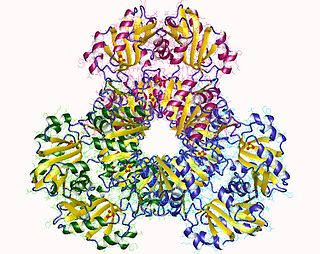Related Research Articles

Ribose-phosphate diphosphokinase is an enzyme that converts ribose 5-phosphate into phosphoribosyl pyrophosphate (PRPP). It is classified under EC 2.7.6.1.

Mitochondrially encoded 12S ribosomal RNA, also known as Mitochondrial-derived peptide MOTS-c or Mitochondrial open reading frame of the 12S rRNA-c is a component of the small subunit (SSU) of the mitochondrial ribosome. In humans, 12S is encoded by the MT-RNR1 gene and is 959 nucleotides long. MT-RNR1 is one of the 37 genes contained in animal mitochondria genomes. Their 2 rRNA, 22 tRNA and 13 mRNA genes are very useful in phylogenetic studies, in particular the 12S and 16S rRNAs. The 12S rRNA is the mitochondrial homologue of the prokaryotic 16S and eukaryotic nuclear 18S ribosomal RNAs. Mutations in the MT-RNR1 gene may be associated with hearing loss.

Gap junction beta-6 protein (GJB6), also known as connexin 30 (Cx30) — is a protein that in humans is encoded by the GJB6 gene. Connexin 30 (Cx30) is one of several gap junction proteins expressed in the inner ear. Mutations in gap junction genes have been found to lead to both syndromic and nonsyndromic deafness. Mutations in this gene are associated with Clouston syndrome.

Forkhead box C1, also known as FOXC1, is a protein which in humans is encoded by the FOXC1 gene.

ERG is an oncogene. ERG is a member of the ETS family of transcription factors. The ERG gene encodes for a protein, also called ERG, that functions as a transcriptional regulator. Genes in the ETS family regulate embryonic development, cell proliferation, differentiation, angiogenesis, inflammation, and apoptosis.

Mitochondrial import inner membrane translocase subunit Tim8 A, also known as Deafness-dystonia peptide or protein is an enzyme that in humans is encoded by the TIMM8A gene. This translocase has similarity to yeast mitochondrial proteins that are involved in the import of metabolite transporters from the cytoplasm into the mitochondrial inner membrane. The gene is mutated in Deafness-dystonia syndrome and it is postulated that MTS/DFN-1 is a mitochondrial disease caused by a defective mitochondrial protein import system.

Sterol O-acyltransferase 1, also known as SOAT1, is an enzyme that in humans is encoded by the SOAT1 gene.

Gap junction beta-3 protein (GJB3), also known as connexin 31 (Cx31) — is a protein that in humans is encoded by the GJB3 gene.

Potassium voltage-gated channel subfamily KQT member 4 also known as voltage-gated potassium channel subunit Kv7.4 is a protein that in humans is encoded by the KCNQ4 gene.

Non-syndromic hearing impairment protein 5 is a protein that in humans is encoded by the DFNA5 gene.

Metastasis-associated protein MTA3 is a protein that in humans is encoded by the MTA3 gene. MTA3 protein localizes in the nucleus as well as in other cellular compartments MTA3 is a component of the nucleosome remodeling and deacetylate (NuRD) complex and participates in gene expression. The expression pattern of MTA3 is opposite to that of MTA1 and MTA2 during mammary gland tumorigenesis. However, MTA3 is also overexpressed in a variety of human cancers.

Eyes absent homolog 4 is a protein that in humans is encoded by the EYA4 gene.

POU domain, class 3, transcription factor 4 is a protein that in humans is encoded by the POU3F4 gene found on the X chromosome.

Transmembrane channel-like protein 1 is a protein that in humans is encoded by the TMC1 gene. TMC1 contains six transmembrane domains with both the C and N termini on the endoplasmic side of the membrane, as well as a large loop between domains 4 and 5. This topology is similar to that of transient receptor potential channels (TRPs), a family of proteins involved in the perception of senses such as temperature, taste, pressure, and vision. TMC1 has been located in the post-natal mouse cochlea, and knockouts for TMC1 and TMC2 result in both auditory and vestibular deficits indicating TMC1 is a molecular part of auditory transduction.

Myosin-XV is a protein that in humans is encoded by the MYO15A gene.

Inactive ubiquitin carboxyl-terminal hydrolase 53 is a protein that in humans is encoded by the USP53 gene.

Gap junction gamma-3, also known as connexin-29 (Cx29) or gap junction epsilon-1 (GJE1), is a protein that in humans is encoded by the GJC3 gene.

Solute carrier family 52, member 3, formerly known as chromosome 20 open reading frame 54 and riboflavin transporter 2, is a protein that in humans is encoded by the SLC52A3 gene.

Membrane metallo-endopeptidase-like 1 is a protein that in humans is encoded by the MMEL1 gene.

Myelin transcription factor 1 like is a protein that in humans is encoded by the MYT1L gene.
References
- ↑ "Human PubMed Reference:". National Center for Biotechnology Information, U.S. National Library of Medicine.
- ↑ "Entrez Gene: Deafness, Y-linked 1".